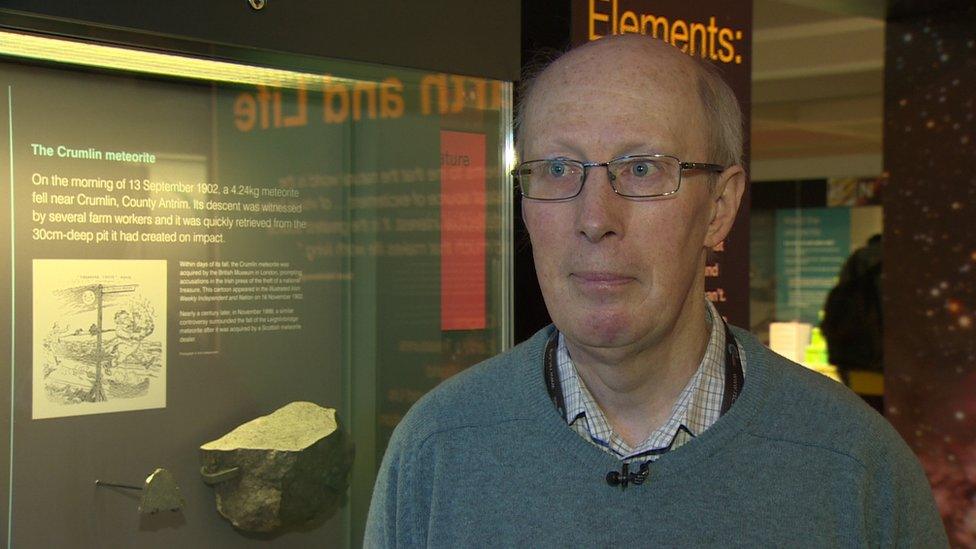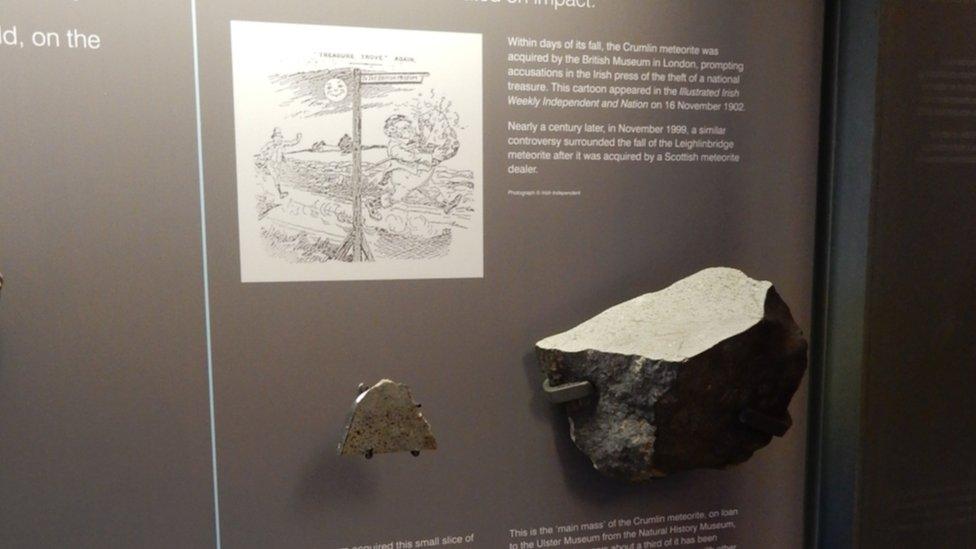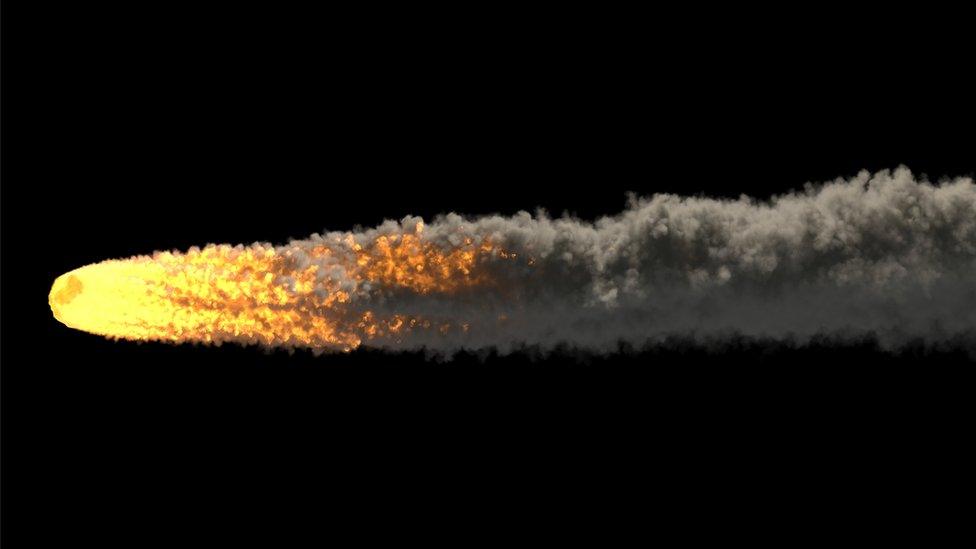Crumlin meteorite returns to Northern Ireland 120 years later
- Published
Crumlin meteorite returns to its 'earthly home'
It journeyed more than a hundred million miles to get to Northern Ireland, but within two weeks it was gone.
Now the Crumlin meteorite is back to its "earthly home" in the Ulster Museum after more than 120 years.
It fell to earth in 1902 and is one of only three to be found in Northern Ireland.
And although it's only the size of a small handbag, it would have created quite an impact in more ways than one.
Meteorites are pieces of rock or iron that fall to earth from space - pieces of debris left over from the formation of the solar system.
Meteors or shooting stars can be seen regularly in the night skies, but meteorites which land on earth are much rarer.
A decade ago one landed in Russia, creating a fireball which lit up the sky and sent out a shockwave which injured hundreds of people.
The Bovedy meteorite, which fell near Limavady in 1969, also created a fireball trail from Wales to Northern Ireland.
The Crumlin meteorite is named after the County Antrim village it landed near in 13 September 1902.
According to Dr Mike Simms from the Ulster Museum, it had travelled a long way to get there.
"It will have come from what's called the asteroid belt, which is an area of debris between the orbit of Mars and Jupiter," he told BBC News NI.
"You're talking about a couple of hundred million kilometres (124 million miles), something like that, it's a long way."
It is also many billions of years old and startled local farm workers as it plummeted to earth, according to Dr Simms.
"They heard various strange noises and some of them likened it to a train running off the track or a boiler exploding in the nearby mill or a swarm of bees," he said.

Dr Mike Simms from the Ulster Museum said the meteorite travelled a long way to get there.
"When it first hit the atmosphere it was going at 30,000 miles an hour so that's a sonic boom basically.
"So people saw it land and there was a guy just 20ft away gathering up apples.
"He saw it hit the ground, he went over and he dug it out."
Armageddon?
There were also striking accounts about the meteorite published at the time.
A report in the magazine Nature in 1902 said it caused a bang heard in both Lisburn and Lurgan, more than 10 miles away.
That also made some locals fear that Armageddon had arrived.
"Some of the hearers had taken the sound to herald the arrival of the Day of Judgement," Nature reported.
But Crumlin was not the end of the meteorite's journey.
By the end of September 1902 it had left Northern Ireland.
Amid some controversy, it was taken to London by Sir Lazarus Fletcher from the Natural History Museum.
Alerted to the meteorite, he bought it from the farm owner on whose land it had fallen, Andrew Walker.
A newspaper cartoon of the time shows a John Bull-like figure running away with the meteorite.

A newspaper cartoon of the time shows a John Bull-like figure running away with the meteorite.
Dr Mike Simms, however, said that would not have been unusual, as all of the island of Ireland was part of the UK at that time and governed from London.
"Within two weeks it had gone back to the national collection of meteorites in the British Museum in London, or the Natural History Museum as it subsequently became," he said.
"They have one of the best collections in the world, so it's understandable it would go there and of course Ireland was part of Britain back in those days so it seemed the natural thing to do," he added.

The meteorite is on display in the Ulster Museum
But, on Monday, the meteorite came "home" to Northern Ireland after more than 120 years, loaned to the Ulster Museum by the Natural History Museum.
"It's fantastic that we've worked with the Natural History Museum to bring it back to Northern Ireland so the people of Northern Ireland can actually see one of their own meteorites," said Dr Simms.
"It's come back home to its earthly home I should say, rather than its home in outer space."
The Crumlin meteorite is expected to stay on display at the Ulster Museum for the next three years.

Meteorite facts
Meteorites are fragments of rock that fall to Earth from space. A meteor becomes a meteorite when it lands.
Scientists estimate that 44 tonnes (44,000kg) of meteoritic material falls on Earth each day.
The ancient Egyptians used meteorites to create high status objects such as jewellery.

Related topics
- Published24 April 2019
